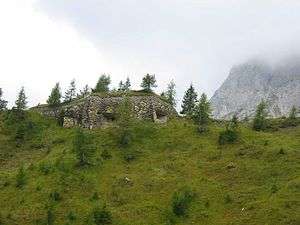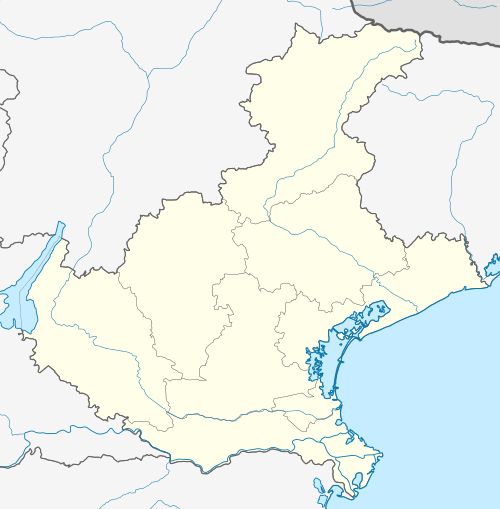Alpine Brigade Cadore
| Brigata Alpina Cadore | |
|---|---|
|
Coat of Arms of the Alpine Brigade Cadore | |
| Active | 1 July 1953 - 10 January 1997 |
| Country | Italy |
| Branch | Italian Army |
| Type | Alpini |
| Role | Mountain Infantry |
| Part of |
IV Army Corps 1953 - 1997 |
| Garrison/HQ | Belluno |
The Alpini Brigade Cadore was a light Infantry brigade of the Italian Army, specializing in mountain warfare. Its core units were the Alpini, the mountain infantry corps of the Italian Army, that distinguished itself in combat during World War I and World War II. The brigade was based in the Italian provinces of Belluno and Vicenza. The headquarters was in the city of Belluno. It was disbanded in 1997.
Constitution
The Cadore was constituted on 1 July 1953 in the city of Belluno. The brigade’s name Cadore alludes to the Cadore Alps in the northernmost part of the province of Belluno. Most of the brigades recruits came from the north-eastern Veneto Region. The brigade was tasked with defending the Piave valley against an attack by forces of the Warsaw Pact. The brigade’s strength was around 3600 men and initially it was composed of the:
-
 7th Alpini Regiment with the battalions
7th Alpini Regiment with the battalions
-
 Headquarter Platoon
Headquarter Platoon -
 Pieve di Cadore
Pieve di Cadore -
 Belluno
Belluno -
 7th Mortar Company
7th Mortar Company
-
-
 6th Mountain Artillery Regiment with the groups
6th Mountain Artillery Regiment with the groups
- Lanzo
- Pieve di Cadore
- Agordo
-

 Logistic Battalion (from 1956 onwards)
Logistic Battalion (from 1956 onwards) -
 Cadore Engineer Company
Cadore Engineer Company -
 Cadore Signal Company
Cadore Signal Company
In the following years the brigade was augmented with further units:
-
 Feltre Alpini Battalion (transferred from the Alpine Brigade Julia on 1 June 1956)
Feltre Alpini Battalion (transferred from the Alpine Brigade Julia on 1 June 1956) - XIX° Frontier Defense Battalion (constituted on January 1, 1957; renamed
 Val Cismon Alpini Battalion on 1 July 1963)
Val Cismon Alpini Battalion on 1 July 1963) -
 Alpini Parachutist Platoon (1956)
Alpini Parachutist Platoon (1956)
The Alpini Parachutist Platoon merged with the other four Alpini Brigades Parachutist Platoons on 1 April 1964 to form an Alpini Parachutist Company under direct command of the 4th Alpine Army Corps.
1975 Reorganization
In 1975 the Val Cismon Alpini Battalion was disbanded and 264th Alpini Company of the battalion was transferred to the Val Brenta Alpini battalion of the Tridentina Alpine Brigade. The Pieve di Cadore Mountain Artillery Group was dissolved. The regimental level was abolished and the remaining units came under direct control of the Cadore Brigade. The new composition was:
-
 Cadore Command and Signal Battalion in Belluno
Cadore Command and Signal Battalion in Belluno -
 Feltre Alpini Battalion in Feltre
Feltre Alpini Battalion in Feltre
-
 Headquarters and Service Company
Headquarters and Service Company -
 64th Alpini Company
64th Alpini Company -
 65th Alpini Company
65th Alpini Company -
 66th Alpini Company
66th Alpini Company -
 125th Heavy Mortar Company
125th Heavy Mortar Company
-
-
 Pieve di Cadore Alpini Battalion in Tai di Cadore
Pieve di Cadore Alpini Battalion in Tai di Cadore
-
 Headquarters and Service Company
Headquarters and Service Company -
 67th Alpini Company
67th Alpini Company -
 68th Alpini Company
68th Alpini Company -
 75th Alpini Company in Santo Stefano di Cadore
75th Alpini Company in Santo Stefano di Cadore -
 167th Heavy Mortar Company
167th Heavy Mortar Company
-
-
 Belluno Alpini (Training) Battalion in Belluno
Belluno Alpini (Training) Battalion in Belluno
-
 Headquarters and Service Company
Headquarters and Service Company -
 92nd Alpini (Training) Company
92nd Alpini (Training) Company -
 127th Alpini (Training) Company
127th Alpini (Training) Company -
 141st Alpini (Training) Company
141st Alpini (Training) Company -
 142nd Alpini (Training) Company
142nd Alpini (Training) Company
-
-
 Lanzo Mountain Artillery Group in Belluno
Lanzo Mountain Artillery Group in Belluno
-
 Headquarters and Service Battery
Headquarters and Service Battery -
 16th Mountain Artillery Battery
16th Mountain Artillery Battery -
 44th Mountain Artillery Battery
44th Mountain Artillery Battery -
 47th Mountain Artillery Battery
47th Mountain Artillery Battery
-
-
 Agordo Mountain Artillery Group in Bassano del Grappa
Agordo Mountain Artillery Group in Bassano del Grappa
-
 Headquarters and Service Battery
Headquarters and Service Battery -
 41st Mountain Artillery Battery
41st Mountain Artillery Battery -
 42nd Mountain Artillery Battery
42nd Mountain Artillery Battery -
 43rd Mountain Artillery Battery
43rd Mountain Artillery Battery
-
-
 Cadore Logistic Battalion in Belluno
Cadore Logistic Battalion in Belluno -
 Cadore Anti-tank Company in Belluno
Cadore Anti-tank Company in Belluno -
 Cadore Engineer Company in Belluno
Cadore Engineer Company in Belluno
Strategic plans in case of war

After the 1976 reform the 4th Alpine Army Corps was responsible to defend the Italian border along the main chain of the alps from the Swiss-Austrian-Italian border tripoint in the west to the Italian-Yugoslavian border in the east. In case of war with Yugoslavia the 4th Alpine Army Corps would remain static in its position guarding the left flank of the Italian V Corps, which would meet the enemy forces in the plains of Friuli-Venezia Giulia. The only brigade which would have seen combat in such a case would have been the Julia.
In case of a war with the Warsaw Pact the 4th Alpine Army Corps had two war planes: one in the case the Soviet Southern Group of Forces and Hungarian Army would march through Yugoslavia and the other in case the Warsaw Pact would violate the Austrian neutrality and march through Austria. In case the enemy forces would come through Yugoslavia, the Julia would cover the mountainous left flank of the 5th Corps, which with its four armoured and five mechanized brigades would try to wear down the enemy before it could break out into the North Italian Padan plain. The other Alpini brigades would remain static.
In the more likely case the Soviet and Hungarian divisions would invade Austria and march through Southern Styria and through the Drava valley in Carinthia the Alpini brigades would have been the first front line units of the Italian Army. The Julia would have defended the Canal valley and the Tridentina the Puster valley, while the Orobica had a special mission and the Taurinense would remain in reserve. The Cadore was stationed between the Julia and the Tridentina brigades and tasked with defending the Piave valley. If the Soviet forces would have advanced along the Drava Valley they would have reached the Italian border at Winnebach in the Puster valley which was defended by the Bassano Alpini Battalion of the Tridentina brigade. The Tridentina was tasked to defend the Puster valley, however if Soviet forces would turn south after crossing the border they would have been able to reach the Piave valley through the Sexten valley and over the Kreuzbergpass or through the Höhlensteintal and over the Cimabanche Pass. Therefore the Pieve di Cadore Alpini Battalion was based in Tai di Cadore and tasked with holding the Kreuzbergpass and Cimabanche pass. The Pieve di Cadore was supported by the Lanzo Mountain Artillery Group in Belluno. The second battalion of the brigade, the Feltre Alpini Battalion in Feltre along with the Agordo Mountain Artillery Group in Bassano del Grappa was tasked to cover the many Dolomite mountain passes on the left flank of the Pieve di Cadore Alpini Battalion.
To aid in the defence of the narrow mountain valleys the 4th Army Corps re-activated some fortifications of the World War II era Alpine Wall. In the area of operation of the Cadore the 264th Alpini Company Val Cismon of the Val Brenta Alpini Battalion was deployed to Santo Stefano di Cadore and tasked with manning the Alpine Wall fortifications on the Kreuzbergpass, in the Höhlensteintal and near Prags:
- Kreuzbergpass: 7 bunker, 247 men (Italian Wikipedia: Sbarramento Passo Monte Croce Comelico)
- Landro Nord: 3 bunker, 150 men (Italian Wikipedia: Sbarramento della Val di Landro)
- Prags: 2 bunker, 116 men (Italian Wikipedia: Sbarramento di Braies)
Administratively the 264th Alpini Company fell under the Tridentina brigade. On 23 August 1986 the company was disbanded and the bunkers stripped of their equipment.
1991 Reorganization
In 1991 the Mountain Artillery Group Agordo was dissolved and the remaining battalions took the names of historical Alpini regiments to carry on their traditions. Each regiment consisted of one of the Brigades Alpini battalions and an additional support company. Furthermore the Anti-tank Company was dissolved and the Command and Signal Battalion was merged with the Engineer Company to form the Command and Tactical Support Battalion. The new composition was:
-
 Cadore Command and Tactical Support Battalion in Belluno
Cadore Command and Tactical Support Battalion in Belluno -
 7th Alpini Regiment
7th Alpini Regiment  Feltre Alpini Battalion in Feltre
Feltre Alpini Battalion in Feltre -
 12th Alpini Regiment
12th Alpini Regiment  Pieve di Cadore Alpini Battalion in Pieve di Cadore (dissolved in 1997)
Pieve di Cadore Alpini Battalion in Pieve di Cadore (dissolved in 1997) -
 16th Alpini Regiment
16th Alpini Regiment  Belluno Alpini Training Battalion in Belluno
Belluno Alpini Training Battalion in Belluno -
 6th Mountain Artillery Regiment Lanzo Mountain Artillery Group in Bassano del Grappa (dissolved on July 15, 1995)
6th Mountain Artillery Regiment Lanzo Mountain Artillery Group in Bassano del Grappa (dissolved on July 15, 1995) -

 Cadore Logistic Battalion in Belluno
Cadore Logistic Battalion in Belluno
Today
The brigade was disbanded on 10 January 1997 and the remaining units (7th and 16th Alpini regiments) passed to the Alpine Brigade Julia.

